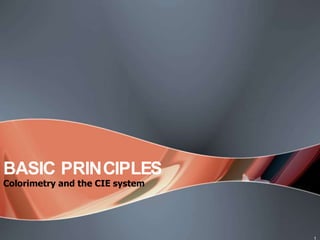
3.2 basic principles
- 1. BASIC PRINCIPLES Colorimetry and the CIE system 1
- 2. BASIC PRINCIPLES It would obviously be difficult to design a system of colour measurement that attempted to describe • the colours that we see. We simply have to think how we use words to describe colours. Colour names such as red, yellow, green and blue are reasonably well understood, but names such as rose, salmon and cerise are • less well standardised. • What might be called rose by one person could be called pink by another. 2
- 3. BASIC PRICIPLES Even for red there is a considerable range of colours which any one person might accept as red. This is not necessarily the same range as for a second person. Experiments with spectrum colours have shown that if one person chooses the wavelength considered closest to a true yellow, a second person might well not agree and claim that the chosen colour is too green or too orange. 3
- 4. The aim of the CIE system The aim of the CIE system is to tell us how a colour might be reproduced (by a mixture of three primary light sources) rather than described. The amounts of the three primaries required to match a particular colour provide a numerical specification of that colour. A different colour would require different amounts of the primaries and hence the specification would be different. It turns out that in many applications this is all that is required. 4
- 5. Colour is thr ee-dimensional, Colour is three-dimensional, a property that is apparent in various ways. Colour atlases arrange colours using three scales (hue, value and chroma in the case of the Munsell system, for example). If we apply a range of concentrations of, say, a yellow dye we can produce a range of yellow samples, but there will generally be many different yellows that cannot be matched – for example, those that are slightly redder than our yellows. With mixtures of our yellow with a red dye we will be able to produce a range of reds, oranges and yellows, but there will be many oranges that we cannot match, including colours that are browner or greyer or less saturated than those actually produced. 5
- 6. M IXTURES OF 3 DYES If we use mixtures of three dyes, however, such as our yellow and red dyes together with a blue dye, we can match a wide range of colours: yellows, oranges, reds and blues, and also browns, grays and so forth. In fact, the only colours that we will not be able to match will be very saturated or very pure colours, such as a purer yellow than that produced by our yellow dye. By choosing particularly bright or pure dyes we will reduce to a minimum the range of colours that cannot be matched. (The widest range of colours can be matched if magenta, yellow and cyan are used as the primaries.) 6
- 7. System of Color Specifications Ignoring the few colours that cannot be produced in this way, we could imagine a system of colour specification in which the concentrations of three specific dyes Required on a particular substrate to match a colour could be used to specify that colour. Of course we would need to specify the light source under which the colour was seen, but the three concentrations would give a numerical specification of the colour; the specification would be different for different colours and it would be possible for someone else to reproduce the colour. Unfortunately there would be serious disadvantages to such a system. The relationship between dye concentrations and any measurable properties of a colour are complex, although definable with modern computers 7
- 8. Moreover, dyes or pigments are rarely pure, and their precise colour depends on the method of manufacture. Even repeat batches from the same plant will not match exactly, and again properties of mixtures are not completely predictable. 8
- 9. Color ed Lights In contrast, coloured lights are much easier to define and reproduce. Imagine a red light obtained by isolating the wavelength 700 nm from the spectrum. Any laboratory in the world capable of measuring wavelength accurately (an objective physical measurement) could produce the same red colour. 9
- 10. Color ed light gr een A green colour corresponding to 546.1 nm could be produced even more readily, since a mercury lamp emits light at only four wavelengths in the visible region (404.7, 435.8, 546.1 and 577.8 nm). By filtering out the other three, the required green wavelength could be obtained. The wavelengths 404.7 and 435.8 nm could be obtained in a similar manner. Small variations in the operating conditions have no significant effect on the wavelengths emitted by a mercury lamp. Hence three primary light sources could be defined simply as appropriate wavelengths and easily reproduced. 10
- 11. M ixtur es of thr ee colour ed lights Mixtures of three coloured lights can be produced in various ways, but the simplest is to imagine three spotlights shining on the same area on a white screen (Figure 3.1). The colour produced would be a mixture of the three colours, and a wide range of colours could be produced by varying the amounts of the three primaries. The colours to be matched could include surface colours illuminated by a particular light source. 11
